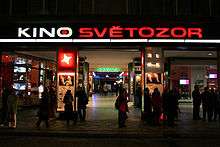Cinema of the Czech Republic
| Cinema of the Czech Republic | |
|---|---|
 Kino Světozor in Prague | |
| Number of screens | 668 (2011)[1] |
| • Per capita | 6.9 per 100,000 (2011)[1] |
| Main distributors |
Bontonfilm 34.0% Falcon 31.0% Warner Bros. 14.0%[2] |
| Produced feature films (2011)[3] | |
| Fictional | 23 (51.1%) |
| Animated | 2 (4.4%) |
| Documentary | 20 (44.4%) |
| Number of admissions (2011)[4] | |
| Total | 10,789,760 |
| • Per capita | 1.06 (2012)[5] |
| National films | 3,077,585 (28.5%) |
| Gross box office (2011)[4] | |
| Total | CZK 1.21 billion |
| National films | CZK 301 million (24.9%) |
The first Czech film director and cinematographer was Jan Kříženecký, who since the second half of the 1890s filmed short documentaries called "Newsreels". The first permanent cinema house was founded by Viktor Ponrepo in 1907 in Prague. Sound was first used in Czechoslovakia in the film Když struny lkají (1930). Then the Czech movie industry experienced a boom period which lasted until WW2. Barrandov Studios were launched in 1933, it is the largest film studio in the country and one of the largest in Europe. At present the studios are often called the "European Hollywood" or "Hollywood of the East" due to increasing interest of western productions.
Famous movies of the 50s include: Journey to the Beginning of Time, The Good Soldier Švejk, The Emperor and the Golem, The Princess with the Golden Star, The Fabulous World of Jules Verne, Proud Princess and Once Upon a Time, There Was a King....
Three Czech/Czechoslovak movies that won the Academy Award for Best Foreign Language Film were The Shop on Main Street (Obchod na korze) by Ján Kadár and Elmar Klos in 1965, Closely Watched Trains (Ostře sledované vlaky) by Jiří Menzel in 1967 and Kolya (Kolja) by Jan Svěrák in 1996. Several others were nominated.
The Czechoslovak New Wave, the golden age of Czech cinema, is most frequently associated with the early works of directors such as Miloš Forman, Věra Chytilová, Jiří Menzel and others, although works by older, more established Czechoslovak directors such as Karel Kachyňa and Vojtěch Jasný are also placed in this category. Encompassing a broad range of fresh and original works in the early to mid-1960s, the Czechoslovak New Wave cannot be pinned down to any one style or approach to filmmaking. Examples range from highly stylised, even avant-garde, literary adaptions using historical themes (e.g. Jan Němec's Diamonds of the Night (Démanty noci)) to semi-improvised comedies with contemporary subjects and amateur actors (e.g., Miloš Forman's The Firemen's Ball (Hoří, má panenko)). However, a frequent feature of films from this period were their absurd, black humour and an interest in the concerns of ordinary people, particularly when faced with larger historical or political changes. The acid western comedy film Lemonade Joe was a famous parody of old-time westerns. Cinematic influences included Italian neorealism and the French New Wave, although the Czechoslovak New Wave also builds organically on developments in Czechoslovak cinema in the late 1950s when directors broke free from the influence of Stalinism in the film industry.
The most viewed Czech film ever is Proud Princess from 1952. It was seen by 8,222,695 people. The film also won a prize for a child film at Karlovy Vary International Film Festival.[6][7]
Marketa Lazarová was voted the all-time best Czech movie in a prestigious 1998 poll of Czech film critics and publicists.[8][9] Among the most successful Czech films after Velvet Revolution include: Kolya, Divided We Fall, Cosy Dens, Loners, I Served the King of England and Walking Too Fast.
Czech films
- List of Czechoslovak films 1898–1990
- List of Czech films (List of Czech Republic films) 1990 - today
List of notable Czech directors
- Jiří Barta a stop-motion animation director
- František Čáp
- Věra Chytilová
- Frank Daniel
- Miloš Forman, twice won the Academy Award
- Martin Frič
- Saša Gedeon
- Juraj Herz
- Jan Hřebejk
- Vojtěch Jasný
- Jaromil Jireš
- Karel Kachyňa
- Karel Lamač
- Oldřich Lipský
- Gustav Machatý
- Jiří Menzel, won the Academy Award
- Jan Němec
- Ivan Passer
- Břetislav Pojar
- Karel Reisz, Czech-born British director
- Bohdan Sláma
- Jan Švankmajer
- Jan Svěrák, twice won the Academy Award
- Jiří Trnka, puppet motion-picture animator
- František Vláčil, his Marketa Lazarová was voted the all-time best Czech movie
- Petr Zelenka
- Karel Zeman
See also
| Wikimedia Commons has media related to Cinema of the Czech Republic. |
- Czech Lion - Annual awards of Czech Film and Television Academy
- Barrandov Studios - Prague's famous film studios (Hollywood of the East).
- Karlovy Vary International Film Festival
- Film Festival Zlín - International Film Festival for Children and Youth
- Ateliery Bonton Zlin - Animation Film Production Company
- Czechoslovak New Wave
- Cinema of the world
References
- 1 2 "Table 8: Cinema Infrastructure - Capacity". UNESCO Institute for Statistics. Retrieved 5 November 2013.
- ↑ "Table 6: Share of Top 3 distributors (Excel)". UNESCO Institute for Statistics. Retrieved 5 November 2013.
- ↑ "Table 1: Feature Film Production - Genre/Method of Shooting". UNESCO Institute for Statistics. Retrieved 5 November 2013.
- 1 2 "Table 11: Exhibition - Admissions & Gross Box Office (GBO)". UNESCO Institute for Statistics. Retrieved 5 November 2013.
- ↑ "Country Profiles". Europa Cinemas. Retrieved 9 November 2013.
- ↑ http://www.csfd.cz/film/10094-pysna-princezna/zajimavosti/
- ↑ http://www.zeroku.com/html/zajimave-clanky/66-nejnavtvovanji-esky-film.html
- ↑ "TOP 10 CESKO-SLOVENSKEHO HRANEHO FILMU". Mestska kina Uherske Hradiste (in Czech). 1998. Archived from the original on 2 October 1999.
- ↑ Marketa Lazarová on kfilmu.net (in Czech)
External links
- GreenCine primer on Czech and Slovak Cinema
- History of Czech cinematography
- List of essential Czech films by Prague Life
- Resources on Czech Cinema, Literature and Politics
| ||||||||||||||||||||||||||||||||||||||||||||||||||||||||||||||||||||||||||||||||